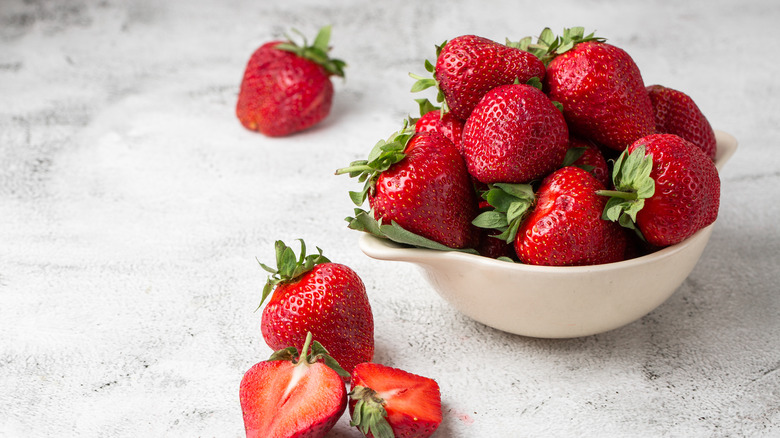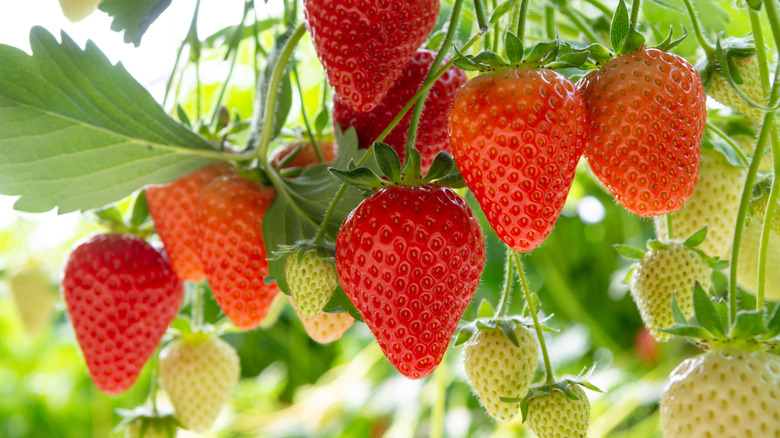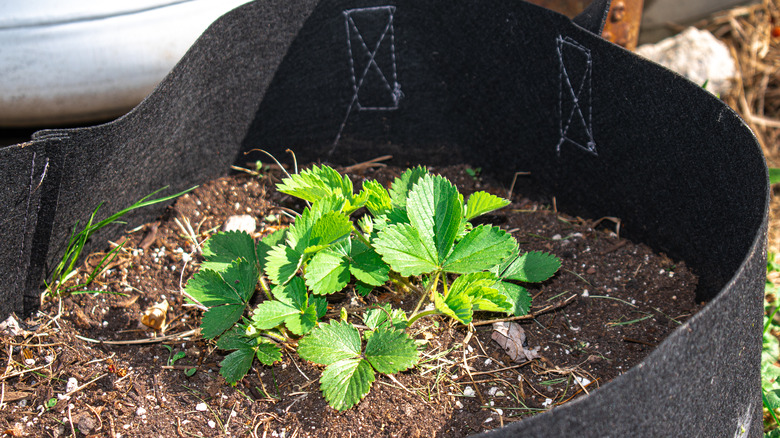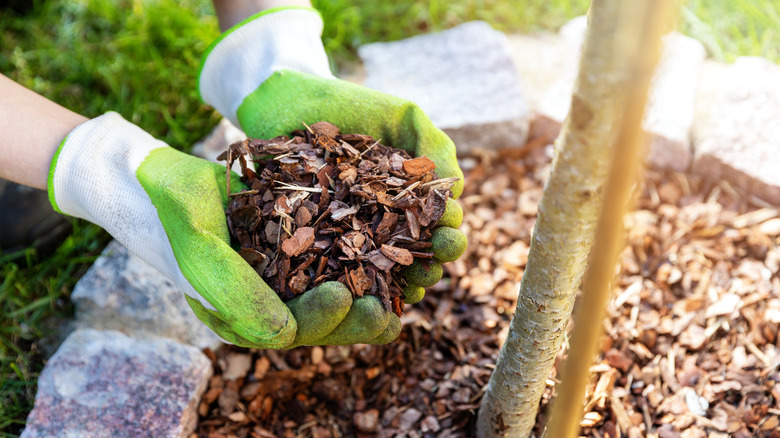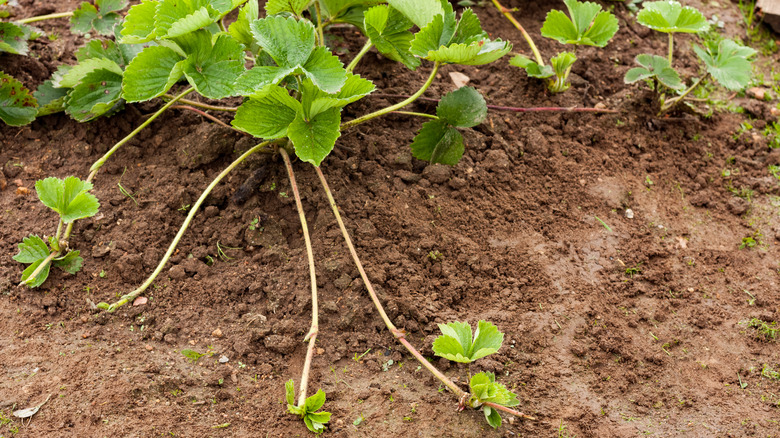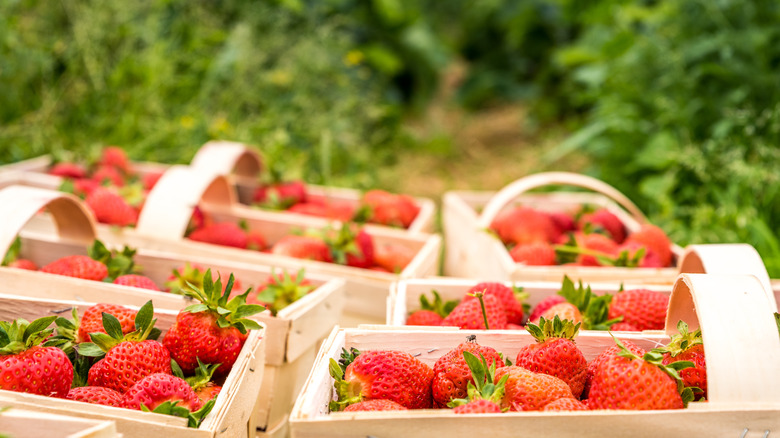Mistakes Everyone Makes When Planting Strawberries
Strawberries pretty much epitomize the flavors of summer. Whether you're having them as part of a fruit salad, in an ice-cold drink, or in a cake, they're sweet, delicious, and the perfect snack for warm weather. Gardening Advice also outlines that strawberries are some of the most versatile produce to grow as they can be planted in the ground or in pots and containers.
Additionally, Gardeners' World explains that since strawberries aren't the cheapest berry to buy, growing your own can make a lot of economic sense. They grow quickly and are fun to tend to, making them the ideal plant to care for with children. The publication also outlines that when it comes to planting your strawberries, they can grow in boxes and on balconies; you can also put them in hanging baskets and grow them in bags. This means you only need a small space that gets lots of sunlight if you don't have a yard or garden.
That being said, if you'd like to turn your outdoor space into a strawberry patch, then there are a few things to consider before you buy the seeds and start digging. Here are some of the most common mistakes everyone makes when planting strawberries. Doing a little bit of research before you begin could mean you get a healthy crop, year after year.
Getting the wrong variety of strawberry
You can pick up strawberries from most supermarkets and fruit and vegetable stalls. However, if you're thinking of growing your own at home, then Grass Trimmers outlines that you need to think about the time of year you're growing them and the space you have as that will dictate the type of berry that you buy. Most strawberries are either summer fruiting, perpetual, day-neutral, or alpine. Each thrives in slightly different conditions and most people grow summer fruiting strawberries.
Gardening Know How explains that perpetual or ever-bearing strawberries produce lots of strawberries throughout spring and autumn, but fewer in summer. Day-neutral varieties of strawberries will produce fruit from early spring until the it starts to get very cold, but you need to make sure you have the time and space to maintain them and harvest the produce.
If growing strawberries is going to be something that you're keen to do in summer, then buying summer fruiting varieties will meet your needs. As ever-bearing and day-neutral varieties produce fruit for a longer period, they may take a little bit more maintenance and care to keep them healthy for years to come. Chowhound explains that before you commit you should ask an assistant at your local plant nursery. Explain where you'll be planting the strawberries, what you want to do with them, and if you have the space for a large harvest. They should be able to point you in the right direction.
Planting strawberries incorrectly
The Royal Horticultural Society explains that there are a few things to keep in mind when you're planting strawberries initially. You'll want to use a mixture of fertilizer and soil, and when you're digging holes for your strawberries, space them to accommodate for their roots and any runners.
Bless My Weeds notes that you'll notice buds that sit close to the ground, which is known as the crown. These buds sit at the base of your plant at soil level. Make sure that you leave the crown exposed and that it sits lightly on the surface. It acts as an anchor or trunk to hold the plant in place, and if it's covered in soil it may die.
Regardless of the type of strawberry variety you choose to grow, Better Homes & Garden adds that you should plant them in a spot that gets at least six hours of sunlight every day. The soil should be moist and well-drained, and you need about ten inches of it. Some strawberry varieties grow long runners facilitating more strawberries. If that's the case then you need to give them plenty of space to grow.
Don't forget to use mulch when planting strawberries
Strawberries require moist soil and sunlight, but Whole Lifestyle Nutrition points out that one of the most common mistakes people make when growing strawberries is not using mulch. The Royal Horticultural Society explains that mulch is a covering that you lay on top of your soil that can bring added benefits when growing plants and produce. It can help suppress weeds, and it may also help your soil retain moisture and create a healthy environment for growth, deter pests, and protect your plant's roots from extreme temperatures.
You can get biodegradable mulch and non-biodegradable mulch. Gardening Know How explains that when it comes to using mulch for strawberries, your main concern is protecting the roots and keeping the plants safe from weeds and pests. It can also keep the ripening berries away from the ground. You can consider using materials like straw, bark, dried leaves, and grass clippings.
Not tackling runners and pests
There are several problems you can run into when growing strawberries that, if you don't tackle them quickly, can kill your plant. The Royal Horticultural Society shares that grey mold can be a serious issue with strawberries. It looks grey and fuzzy and is most common in damp or humid climates. The only thing you can do to remedy this is to cut away the affected part of the plant, so spotting it quickly may mean you can save more of your strawberry plant.
Another issue you may run into is mildew, which appears to be white and powdery on the leaves of your strawberry plant. To fix this you'll need to make sure the soil is kept moist and, if possible, move your strawberry plant to a location that's colder.
Runners often grow off strawberry plants and, while this may seem like a beneficial thing, it's worth keeping an eye on how many runners are sprouting out of your plants. Bless My Weeds explains that one of the biggest mistakes that gardeners can make is not removing runners from their strawberry plants. Your main plant can usually handle three runners, but the more runners a plant has, the fewer nutrients are going directly to it.
Harvesting the strawberries wrong
One last mistake that Love Food says many gardeners make when growing strawberries is harvesting them wrong in their first year, so the plant isn't in the best condition it could be for the year to come. The Royal Horticultural Society notes that depending on the type of strawberry variety you're growing, harvesting months are typically June to September.
You'll know your strawberries are ready to pick when they're red all over and look plump. You should pick them in the warmest part of the day as that's when they'll taste the best. While some fruit can be kept for a long period after being harvested, strawberries are best eaten pretty soon after they've been picked and they don't keep so well if frozen.
Better Homes & Gardens explains that most strawberries will be ready to harvest around four to six weeks after the plant has blossomed. It can be tempting to pluck the ripe fruit straight off the plant. However, this may damage it for future harvests. Instead, take some scissors and trim the stems. You can then separate the fruit and eat them.
